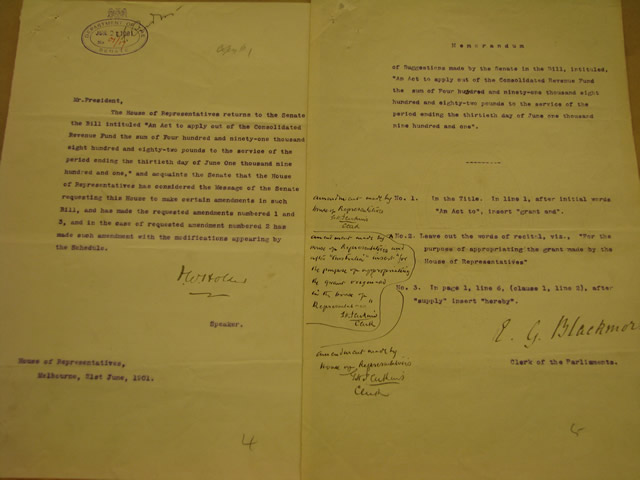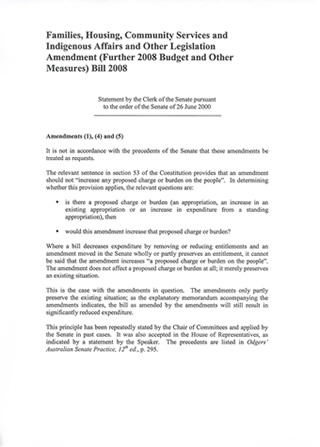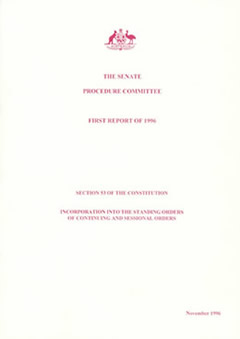140 Requests on bills not amendable by the Senate
-
Requests to the House of Representatives may be made at all or any of the following stages of a bill which the Senate may not amend:
-
On the motion for the first reading of the bill.
-
In committee after the second reading has been agreed to.
-
On consideration of any message from the House of Representatives referring to the bill.
-
On the third reading of the bill.
-
A committee may recommend that the Senate make, press, or modify, and may generally deal with, requests on the bill.
-
Proceedings in committee shall be as follows:
-
The chairman shall call on each clause or item, and put the question – That the clause or item be now passed without requests.
-
If motions for requests are moved and passed, the chairman shall put a further question – That the clause or item be now passed, subject to the requests being complied with.
-
If either of those questions is negatived, it shall again be proposed by the chairman, and consideration of the clause or item may continue until either question is agreed to.
-
At the request of a senator a clause or item shall be divided.
-
When a request to the House of Representatives is made a message shall be sent to the House of Representatives returning the bill and requesting the House to make amendments in the bill in accordance with the request.
Amendment history
Adopted:
- Paragraph (1) adopted 9 September 1909, J.121 (to take effect 1 October 1909) as SO 240A but renumbered as SO 247 for the 1909 edition
- Paragraphs (2), (3) and (4) adopted 19 August 1903 as SOs 248 (corresponding to paragraphs (2) and (3)) and 243 (paragraph (4)), but renumbered as SOs 244 and 241 for the first printed edition
Amended:
- Paragraph (3) amended 22 March 1972, J.917 (to clarify proceedings during the committee stage)
- Paragraph (4) amended 9 September 1909, J.121 (to take effect 1 October 1909) (consequential amendment on the adoption of paragraph (1))
1989 revision: Old SOs 252 to 254 combined into one, restructured as four paragraphs and renumbered as SO 140; reference to the application of old standing order 265 in paragraph (3) replaced with a clear statement of procedures to apply; language modernised and expression considerably streamlined, including by superseding the consequential amendments in 1909 to paragraph (4)
Commentary
Section 53 of the Constitution provides that the Senate may not amend certain bills and may not make amendments to any bill that would have the effect of increasing the charge or burden on the people. In these circumstances, the Senate may at any stage return the bill to the House of Representatives and request that House to amend the bill. Section 53 was based on the South Australian Compact of 1857 which similarly differentiated between the powers of the upper and lower Houses. It was not part of the South Australian Constitution, however, and, according to Senator Playford (Prot, SA), there were no written practices or standing orders from that state for the Senate to study when it came to developing its own standing orders.[1]

The message from the House of Representatives in relation to Supply Bill (No. 2) 1901 02 agreeing to the Senate's requests for amendments to the bill's preamble to clarify that the grant of supply was made by both Houses (with annotations by E.G. Blackmore)
The first, rather sketchy proposals in the Standing Orders Committee’s Third Report, tabled on 9 October 1901, were modified after the Senate’s experience in dealing with the Customs Tariff Bill 1901 –02. A second scheme, presented in the committee’s Special Report on Proceedings on Bills which the Senate may not Amend and on Appointment of Committee of Disputed Returns and Qualifications, tabled on 4 June 1903 (PP No. S.1 /1903), contained more detail about how request bills would be handled in committee of the whole and procedures to be followed in the event that the House of Representatives did not make the requested amendment (see SO 141). Both schemes limited the Senate to three attempts before resort could be had to a free conference.
When these replacement standing orders were debated on 11 June 1903, it was clear that further work was still necessary. Some senators thought that joint standing orders were required because the matter involved negotiations between the Houses; or, at the very least, that it was necessary to seek the views of the House. Other senators were concerned that the “three attempts” rule was an unwarranted limitation on the rights of the Senate to have maximum freedom in reaching agreement with the House. A decision on the standing orders was postponed.
Before debate resumed in August, the Standing Orders Committee had corresponded with its counterpart committee in the House and provided to it a copy of the proposed standing orders dealing with the “three attempts” rule and the pressing or modification of requests not made by the House. A report was presented on 23 July 1903 and included the exchange of correspondence between the President and the Speaker.[2] Having thanked the Senate committee for its courtesy, the Speaker, as chair of the House Standing Orders Committee, informed the President that there was “nothing in the Standing Orders as recommended by it [the House committee] to the House of Representatives for adoption that is in conflict with the two proposed Standing Orders of the Senate”.
That the House did not take issue with the Senate’s proposals was of little comfort to those senators who had been uncomfortable with these standing orders in the first place. Another complication emerged when the debate resumed in August 1903; namely, that the House, having more or less acquiesced in the Senate’s proposals, might take it as a discourtesy if the Senate now declined to adopt them. In the end, the Senate rejected the “three attempts” rule but retained the standing order dealing with the pressing and modification of requests (see SO 141) in the group of standing orders adopted to deal with these matters.

A statement of reasons for amendments being circulated in the form of requests
While the original parts of the standing order dealt with requests in committee of the whole, s.53 of the Constitution referred to the ability of the Senate to make requests “at any stage”. The right of the Senate to reiterate or “press” requests was assumed from the beginning. C. B. Boydell, in his booklet on money bills, referred to the failed amendment to the draft Constitution to replace the phrase “at any stage” with “once”.[3] An amendment to leave out the whole paragraph was also negatived.[4] The assumption that the reiteration of requests was permissible was inherent in the “three attempts” rule. It was an assumption that had been put into practice in the case of the Customs Tariff Bill 1901 –02 (see SO 141).
The question of when requests could be made had been partly established in practice by the Senate’s handling of the first two Supply Bills in 1901. A request was made on the motion for the second reading of Supply Bill (No. 1) 1901 –02 for the House to amend the bill to provide details of the items of expenditure under the general amounts.[5] On Supply Bill (No. 2) 1901 –02, a request was made after the adoption of a report from the committee of the whole for the amendment of the preamble to clarify that the grant of supply was made by both Houses.[6]
In 1909, the Senate adopted the predecessor of paragraph (1) to specify, but not limit, the stages of a bill at which requests could be made. The Standing Orders Committee had proposed for adoption a form of the present paragraph (1) but without subparagraph (a) (on the motion for the first reading). President Gould, however, moved the adoption of the new standing order in an amended form, including the reference to the first reading. He argued that, on second thoughts, the Senate’s experience with the Supply Bills in 1901 supported an option for requests to be made at a very early stage where such fundamental issues as were raised by those bills were concerned.[7] The purpose of this new standing order was to affirm the Senate’s claim to the right to make a request more than once and to “lay down what we consider to be our rights, duties and privileges in this connexion”.[8] Although the motion for the second reading was not a specified stage, President Gould explained:
If at any time it were held to be urgently necessary that the Senate should make a request at a stage other than that mentioned in the proposed standing order the adoption of it would not preclude that being done, but, of course, a very strong reason would have to be advanced to justify the adoption of such a course.[9]
Requests have been made or proposed on the second reading motion, but most requests are made in committee after the second reading has been agreed to. See Odgers’ Australian Senate Practice, 12th edition, pp. 303–304 for precedents and Appendix 6 of that work for a list of bills to which the Senate has made requests since 1901.
Except as provided in SOs 140 and 141, bills which the Senate may not amend are dealt with in the same way as other bills. One important difference, however, is in relation to proceedings in committee. The normal questions in committee, “that the clause stand as printed” (SO 116) or “that the clause stand as amended” (SO 118(3)), cannot be used because an equally divided vote or a majority for the noes would result in the question being lost and the clause being removed from the bill; in other words, it would result in the bill being amended. To avoid this unconstitutional result, the earlier form of paragraph (3) provided for the chair to call on each clause or item and ask if any senator had any request. The chair would then declare a clause or item passed if no request had been moved or if a request had been moved and negatived.
Difficulties were encountered in 1970 when, in debate in committee of the whole on an Appropriation Bill, an item was under consideration and the chair had asked whether there were any requests. A motion for the closure (“that the question be now put”) was carried and the minister argued that the question should be put on the item before the committee (with potentially unconstitutional results). The chair instead put the question, “Are there any requests?” which was negatived, allowing the chair to declare the item passed. The matter was considered by the Standing Orders Committee which proposed some improvements to the standing order as it then stood. These were adopted by the Senate on 22 March 1972.[10]
The form of the question in committee of the whole on a bill which the Senate may not amend is:
That the bill/clause/item be now passed without requests.
Opposition to a clause or item takes the form of a request to omit the clause or item, and must be supported by a majority. If either of the questions provided by subparagraphs (3)(a) and (b) is negatived, the other may be proposed notwithstanding the rule in SO 144(3) that a motion contradictory of a previous decision of a committee may not be entertained in the same committee. The aim is for the bill to be agreed to either without requests or subject to requests being made to the House of Representatives. In the latter case, any final decision on whether the bill should or should not pass is withheld until the response of the House to the requests is known. There are also further opportunities to make requests on the consideration of a message from the House and on a motion for the third reading of the bill. See Odgers’ Australian Senate Practice, 12th edition, pp.305–08 for further analysis, including of the impact of equally divided votes on the questions provided by subparagraphs (3)(a) and (b).

The procedure Committee report on section 53 of the Constitution
Differences with the House of Representatives over the Senate’s rights in relation to requests have been referred to. In the 1990s the Legal and Constitutional Affairs Committees of the two Houses each undertook an inquiry into the interpretation and application of the third paragraph of s.53 of the Constitution (“The Senate may not amend any proposed law so as to increase any proposed charge or burden on the people”). Unable to complete the inquiry because of a heavy workload, the Senate Legal and Constitutional References Committee recommended that the inquiry be transferred to the Procedure Committee with a suggestion that the committee examine the feasibility of a compact between the Houses on the operation of the third paragraph.[11]
The Procedure Committee took into account the evidence gathered by the Legal and Constitutional References Committee and the two reports of the equivalent House committee[12] and, in its First Report of 1996 (PP No. 194/1996), proposed a scheme for the application and interpretation of the third paragraph of s.53. The recommendation that the Senate adopt the scheme as the terms of an agreement between the Houses, and seek the concurrence of the House of Representatives, was never acted on.
The issue emerged again in 2000 when the Senate considered a message from the House in relation to the New Business Tax System (Miscellaneous) Bill 1999. The House had disagreed with amendments made by the Senate but made identical amendments of its own to which it sought the Senate’s agreement. The amendments, though circulated as requests, had been moved in the Senate as Government amendments following a statement by the Chair of Committees (Senator West) that there appeared to be no basis for taking them as requests. Eventually, an explanation was provided as to why the amendments had been circulated as requests. The explanation revealed circumstances that would normally have been dealt with by way of requests and the Senate therefore agreed to the amendments made by the House. Before doing so, however, the Senate agreed to a resolution requiring that all future amendments circulated in the form of requests be accompanied by a statement explaining why they had been framed as requests. The Clerk of the Senate was also required to provide a statement on whether the amendments would be regarded as requests under the precedents of the Senate.[13]
The scheme proposed by the Procedure Committee in 1996 had included a requirement for ministers to provide the Senate with explanations of the impact of amendments to bills covered by the third paragraph of s.53. The explanation would provide a basis for determining whether the amendments should be moved as requests. This idea was now extended to apply to all amendments circulated by any senator in the form of requests.[14] Statements of reasons for amendments being framed as requests are incorporated in Hansard, by leave, immediately after the requests to which they relate.
A message required by paragraph (4) takes the following form if the bill has been agreed to without requests:
Message No.
Mr Speaker
The Senate returns to the House of Representatives the bill for <long title of bill>, and informs the House that the Senate has agreed to the bill without requests for amendments.
President
The Senate
<date>
[<short title of the bill>]
The following variation is used when requests have been agreed to:
The Senate returns to the House of Representatives the bill for <long title of bill>, and requests the House to make the amendments in the annexed schedule.